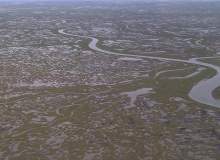
The Bovanenkovo-Ukhta gas trunkline system (GTS) is a 1,100km-long gas transmission line built in Russia. Owned and operated by Gazprom, the pipeline has a design capacity of 140 billion cubic metres (bcm) a year.
The GTS is part of Russia’s Yamal Megaproject. Launched in 2002, the project aims to develop oil and gas fields in the Yamal Peninsula. Delivering gas produced in the Yamal Peninsula to central Russia is essential to ensure future growth of the region.
A 2,500km gas transmission network was developed to deliver gas from the Yamal Peninsula to Russia’s unified gas supply system. The Bovanenkovo-Ukhta GTS is part of this network.
Planning for the GTS project started in October 2006. Construction of the pipeline began in 2007 and was completed in October 2012.
Construction and infrastructure
The GTS includes two 1,100km linear sections and one four-line 71km long submerged section across the Baidarata Bay, a gulf in the Kara Sea.
The above ground sections have a diameter of 1,420mm and a wall thickness of 27mm. The submerged section has a diameter of 1,200m. The pipes have a triple-layer polyethylene external coating and an inner smooth lining.
Construction of the pipeline was carried out under harsh engineering and environmental conditions. Most of the construction area is covered with permafrost with temperatures varying from -2.5°C to -6.5°C. In some areas construction activities were hindered due to the presence of thawed soils.
Construction of the submerged section started in August 2008. The pipes of the submerged sections are designed with 120atm pressure and are encased in concrete. By December 2011, the first line of the submerged section was completed and tested. The second and third lines were completed and tested in 2012.
The Bovanenkovo-Ukhta GTS includes nine compressor stations at Baidaratskaya, Yarynskaya, Gagaratskaya, Vorkutinskaya, Usinskaya, Itinskaya, Syninskaya, Chikshynskaya and Maloperanskaya.
Pre-commissioning works at the Baidaratskaya compressor station were carried out in December 2011.
Reserves and contractors
The Yamal Peninsula comprises 11 gas and 15 oil, gas and condensate fields with nearly 16 trillion cubic metres (tcm) of estimated gas reserves and 22tcm of probable reserves. Condensate reserves of the Yamal Peninsula are estimated at 230.7Mt and oil reserves at 291.8Mt.
Development of gas fields in the Yamal Peninsula is expected to increase gas production in Russia to 310-360bcm per annum by 2030.
The Bovanenkovskoye field is a major resource of the Yamal Peninsula with an estimated 4.9tcm of gas reserves. Production from the field is expected to increase to 140bcm per annum in the future.
ChelPipe was contracted to supply 20,000t of pipes for the project. TMK supplied more than 70,000t of K65 grade longitudinal welded pipes for the project. Vyksa Steel Works provided 100,000t of pipes.
TITAN-2 supplied the noise-absorbing shelters for the gas turbines of the pipeline. The shelters were used for suppressing noise during gas turbine installation.
Six gas compressor units (GCU) were ordered from by Iskra-Turbogaz. Each GCU includes a 16.47MW gas turbine manufactured by the Perm Engine Company, a compressor produced by Iskra and an automatic control system supplied by Sistema-Servis. VNIPIgazdobycha was the general designer for the GCUs.
Zvezda-Energetika won a contract to supply nine power plants, one each for the compressor stations of the pipeline. Each station includes gas power units rated at 1.1-1.5MW and stand-by diesel power units rated at 0.6-1MW.
Stroygazconsulting was involved in the construction of a few sections of the pipeline. Podvodtruboprovodstroy was involved in the construction of the linear section of the pipeline and river crossings of some of the main pipeline.



